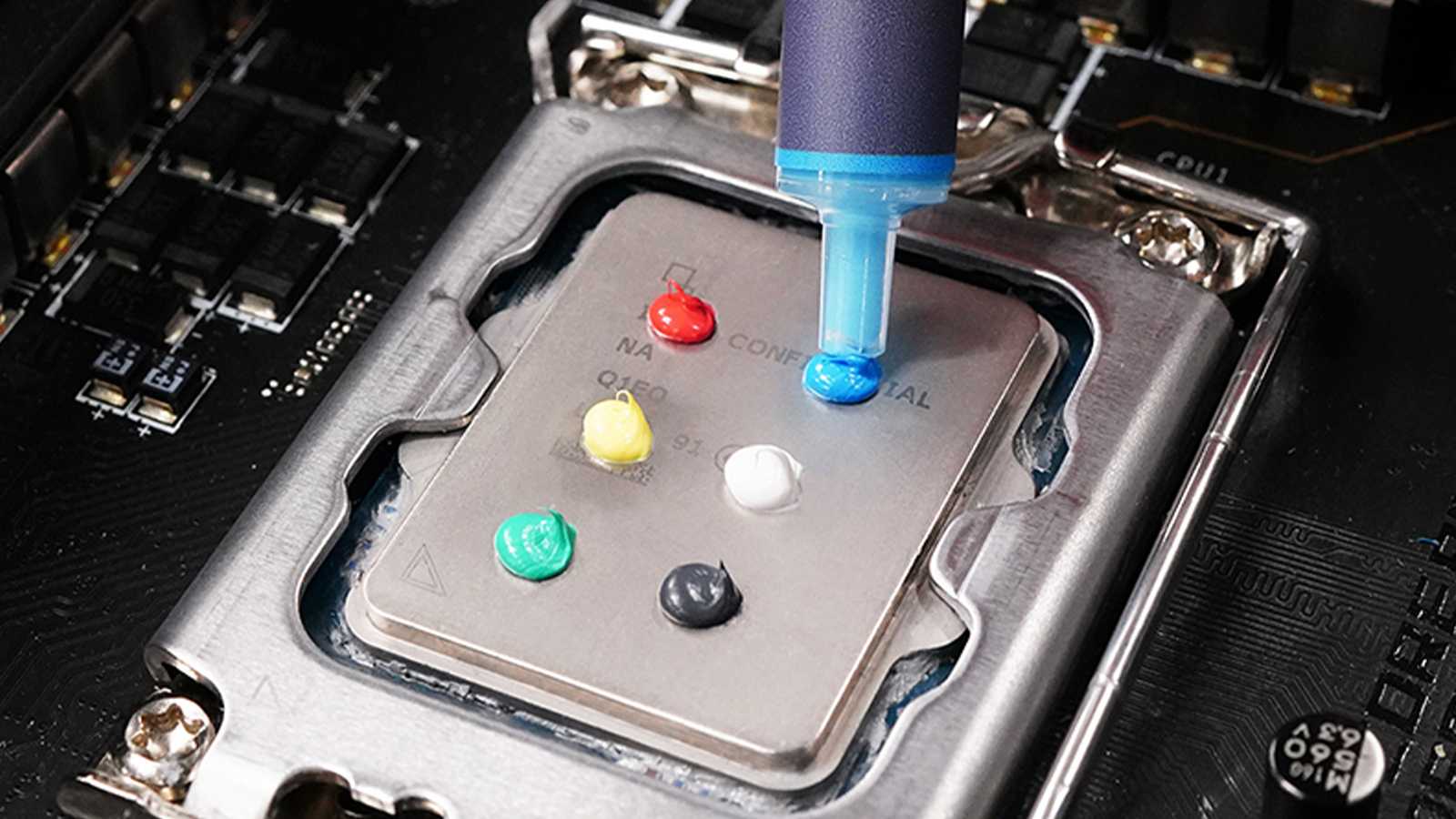Cooler Master introduces colored ‘AI Thermal Paste’ — CryoFuze 5 comes with nano-diamond technology

Cooler Master just released a new line of CryoFuze 5 'AI Thermal Paste' that comes in six different colors. The company uses zinc oxide and aluminum powder to make the colorful thermal paste, while also claiming that it uses 'nano-molecular technology' to deliver stable performance.
While the added colors are likely just a gimmick or for creators filming their PC builds, the bigger claim here is the thermal paste’s performance and stability across a wide range of temperatures. According to the CryoFuze 5 China product page, the thermal paste has a thermal conductivity coefficient of 12.6 W/mK, giving it better performance than all other thermal pastes we’ve tested in our Best Thermal Paste for 2024 guide, save for the SYY 157 that has a rating of 15.7 W/mK. It won't match the values you can get from liquid metal thermal pastes, however, which offer thermal conductivity ratings of 73 W/mK or higher.


Cooler Master uses the AI branding on CryoFuze 5, but there is nothing AI about a thermal paste solution. While perhaps Cooler Master could've designed it for AI processors, especially as next-generation AI chips like Intel’s Falcon Shores and Nvidia’s B100 and B200 GPUs have TDPs higher than 1,000 watts, the CryoFuze 5's thermal performance isn’t that far ahead of its competitors.
The CryoFuze 5 might not mean much for the average PC builder. But enthusiasts looking for style points on their video builds might love it (even though no one will ever see it again once the PC is assembled, unless they take the CPU cooler off). This also isn’t the first colored thermal paste from Cooler Master, as it already sells the CryoFuze Violet thermal grease.
More importantly, the CryoFuze 5’s high thermal conductivity (for a thermal paste) allows overclockers to push high-performance silicon even more. This is particularly crucial for builders using more exotic solutions, like using the EKWB AIO liquid-cooler designed for delidded CPUs, or those who replace the stock heat spreader on the processor with a custom one from Thermal Grizzly.
The stability of Cooler Master’s colorful thermal paste adds another advantage, especially for overclockers who aim to get the most out of their silicon. If you’re one of the few who use liquid nitrogen to cool your PC, you'll appreciate the CryoFuze 5's ability to work from -50C to 240C.
Liquid metal should still perform better than the CryoFuze 5, but it comes with the added risk of shorting components as it's a conductive material. While the color options and AI branding are likely just for marketing purposes, its improved performance should help enthusiasts looking to redline their systems.
Get Tom's Hardware's best news and in-depth reviews, straight to your inbox.

Jowi Morales is a tech enthusiast with years of experience working in the industry. He’s been writing with several tech publications since 2021, where he’s been interested in tech hardware and consumer electronics.
-
Dr3ams "The company uses zinc oxide and aluminum powder to make the colorful thermal paste..."Reply
I read somewhere that it's not a good idea for zinc and copper to have contact with each other for longer periods of time. Many heatsinks are made of copper. -
PEnns Ah, AI thermal paste!..... Well that didn't take long, the milking of everything AI continues!Reply
It seems Cooler Master (and probably some users of this paste) are under the impressions that their paste will be in full visible glory to dazzle anyone who cares. -
artk2219 Reply
Zinc oxide has been a main component in some thermal pastes for a LOOONNNGGGG time, decades, id say its pretty safe to use hah. Although it may discolor the copper base plate, it doesn't harm anything.Dr3ams said:"The company uses zinc oxide and aluminum powder to make the colorful thermal paste..."
I read somewhere that it's not a good idea for zinc and copper to have contact with each other for longer periods of time. Many heatsinks are made of copper.
https://www.arrow.com/en/research-and-events/articles/thermal-paste-a-critical-tool-for-heat-management -
bill001g So what is new I thought there have been colored thermal paste for a while, if I remember they are sold in japan and are also scented.Reply
Maybe its just because a larger cooling company started selling stupid stuff too. -
derekullo 'nano-molecular technology' to deliver stable performanceReply
In other words we have a fancy blender! -
Papusan What kind of sloopy journalism is this from Tomshardware? See for yourself... The stability of Cooler Master's colorful thermal paste adds another advantage, especially for overclockers who aim to get the most out of their silicon. If you're one of the few who use liquid nitrogen to cool your PC, you'll appreciate the CryoFuze 5's ability to work from -50C to 240C.Reply
Why would LN2 overclockers use this new thermal paste that isn't intended to be used below -50C ? They operate more with temps down to -192C. In short... This fancy colored thermal paste is useless for them. -
Notton Reply
Probably this?Dr3ams said:"The company uses zinc oxide and aluminum powder to make the colorful thermal paste..."
I read somewhere that it's not a good idea for zinc and copper to have contact with each other for longer periods of time. Many heatsinks are made of copper.
https://www.vmzinc.com/us-en/technical-support/basic-principles/compatibility
Key differences here: It's zinc oxide, so it's already "corroded", and there is no water (or at least there shouldn't be)